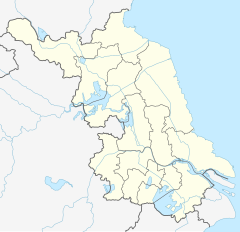| Ming Ancestors Mausoleum | |
|---|---|
明祖陵 | |
 The Southern Gate of the tomb complex | |
Location in Jiangsu | |
| General information | |
| Architectural style | Chinese (Ming) |
| Town or city | Xuyi Huai'an Prefecture Jiangsu Province |
| Country | China |
| Coordinates | 33°4′55.81″N 118°28′39.63″E / 33.0821694°N 118.4776750°E |
| Construction started | Hongwu 19[1] 1386[2] |
| Completed | Yongle 11[1] c. 1413 |
| Ming Ancestors Mausoleum | |||||||||
|---|---|---|---|---|---|---|---|---|---|
 | |||||||||
| Chinese | 明祖陵 | ||||||||
| Literal meaning | Tomb of the Ancestors of the Ming | ||||||||
| |||||||||
| First Tomb of the Ming | |||||||||
| Chinese | 明代第一陵 | ||||||||
| Literal meaning | First Burial Mound of the Ming Era | ||||||||
| |||||||||
The Ming Ancestors Mausoleum, Ming Ancestor Tomb,[3] or Zuling Tomb[4] was the first imperial mausoleum complex of the Ming dynasty, constructed at a geomantically advantageous site near the inlet of the Huai River[5] into the west side of Hongze Lake in present-day Xuyi County, Huai'an Prefecture, Jiangsu Province, China. Built between 1386 and 1413 by Zhu Yuanzhang—the Hongwu Emperor who founded the Ming—and his son Zhu Di the Yongle Emperor to display their filial piety,[6] it was located north of the town of Sizhou, where the ancestors of the dynasty had lived. The remains of the Hongwu Emperor's grandfather Zhu Chuyi are known to have been disintered and moved to the site. He, his father Zhu Sijiu, and his grandfather Zhu Bailiu[2] were posthumously revered at the site as honorary emperors, Zhu Chuyi as the Xi Ancestor of the Ming (Xizu), Zhu Sijiu as the Yi Ancestor of the Ming (Yizu), and Zhu Bailiu as the De Ancestor of the Ming (Dezu).[2]
The site was flooded by the lake in the 1680s, when the Yellow River still flowed into the Huai. It was not uncovered until the 1960s. During the 1970s and 1980s, earthworks were raised to protect the site from further flooding, after which it was restored as a cultural tourism site by the State Administration of Cultural Heritage of the People's Republic of China. Most of the original statues of the sacred way have been recovered and restored, although some of the gates and halls remain as ruins.
- ^ a b Yuanlin (2008).
- ^ a b c SACH (2000), p. 173.
- ^ Danielson (2008).
- ^ SACH (2000), p. 171.
- ^ "Huaian". Jiangsu.NET,2006-2011. Retrieved 24 April 2012.
- ^ SACH (2000), p. 179.
